Training and Development as a Strategic Tool for Organizations
VerifiedAdded on 2023/05/29
|11
|1722
|474
Essay
AI Summary
This essay critically evaluates the significance of training and development in organizational strategic decision-making, linking it to enhanced effectiveness, performance, and sustainability. It discusses how training equips employees with necessary skills, prepares them for future roles, and increases organizational productivity. The essay also highlights the steps involved in aligning training needs with organizational strategy, including training needs assessment, objective setting, method selection, implementation, and evaluation. Furthermore, it examines the advantages of training, such as creating a pool of readily available replacements, enhancing the ability to adopt new technology, and improving employee competence. Finally, the essay addresses the implications of not implementing training, such as slow growth, high turnover, and inadequate staffing. The document is available on Desklib, a platform offering a wide range of study resources.
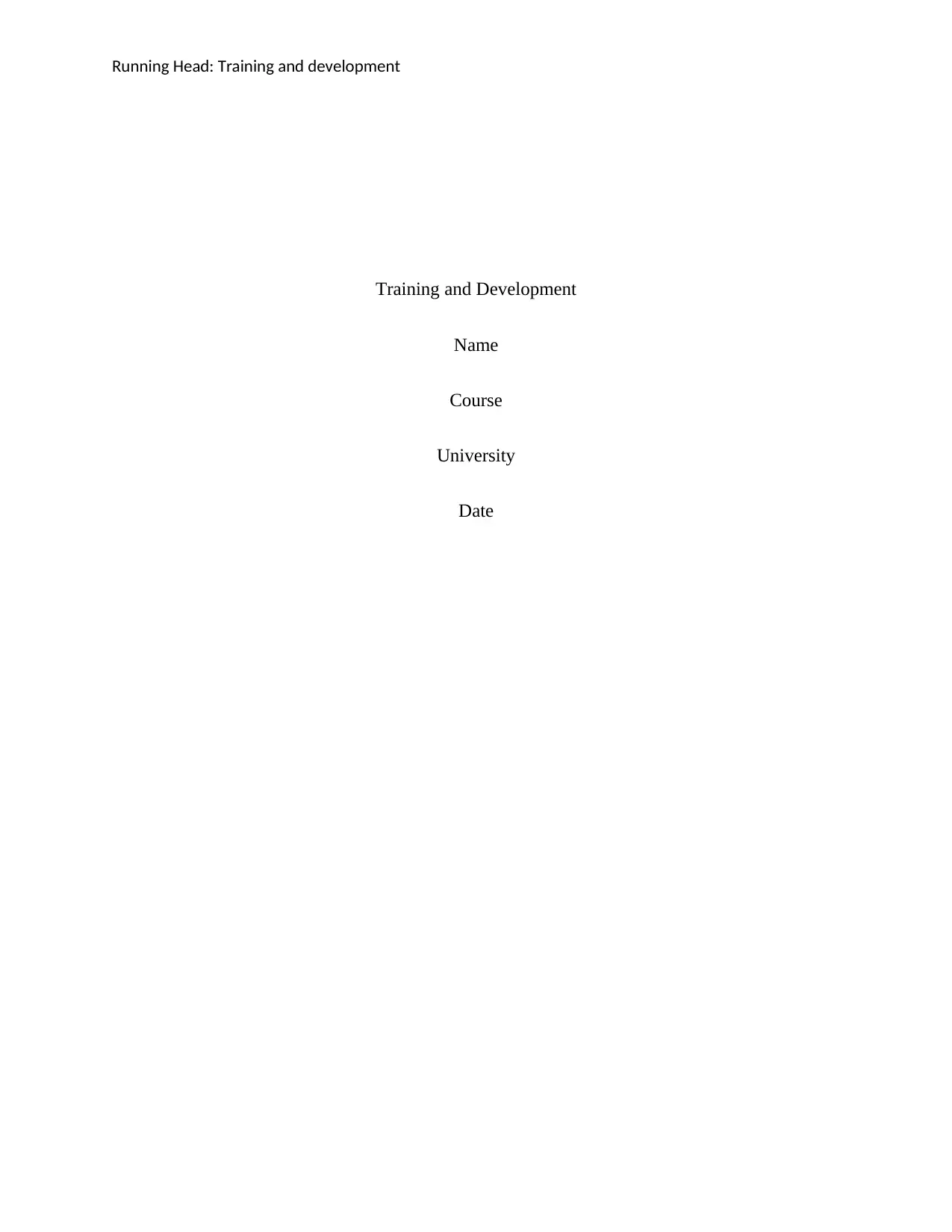
Running Head: Training and development
Training and Development
Name
Course
University
Date
Training and Development
Name
Course
University
Date
Paraphrase This Document
Need a fresh take? Get an instant paraphrase of this document with our AI Paraphraser

2
Abstract
The success of the organization relies heavily on the skills of the work force. This is because
skilled employees enhance the timely achievement of the set objectives within the organization.
Skilled employees enable the organization to achieve a sustainable competitive advantage over
the others hence its long term success. Training and development is an essential element for a
competent work force within the organization. An organization that invests in the regular training
of its employees usually excels both locally and internationally. This is because the employees
are the key assets of the organization. Training and development equips employees with relevant
knowledge and skills required to perform their various tasks within the organization. It also
enables the employees to cope with the continuous changes in the external business environment.
Organizations that do not train employees hardly performs well hence training and development
of employees is not an exception for an organization that wishes to excel both locally and
internationally.
Abstract
The success of the organization relies heavily on the skills of the work force. This is because
skilled employees enhance the timely achievement of the set objectives within the organization.
Skilled employees enable the organization to achieve a sustainable competitive advantage over
the others hence its long term success. Training and development is an essential element for a
competent work force within the organization. An organization that invests in the regular training
of its employees usually excels both locally and internationally. This is because the employees
are the key assets of the organization. Training and development equips employees with relevant
knowledge and skills required to perform their various tasks within the organization. It also
enables the employees to cope with the continuous changes in the external business environment.
Organizations that do not train employees hardly performs well hence training and development
of employees is not an exception for an organization that wishes to excel both locally and
internationally.
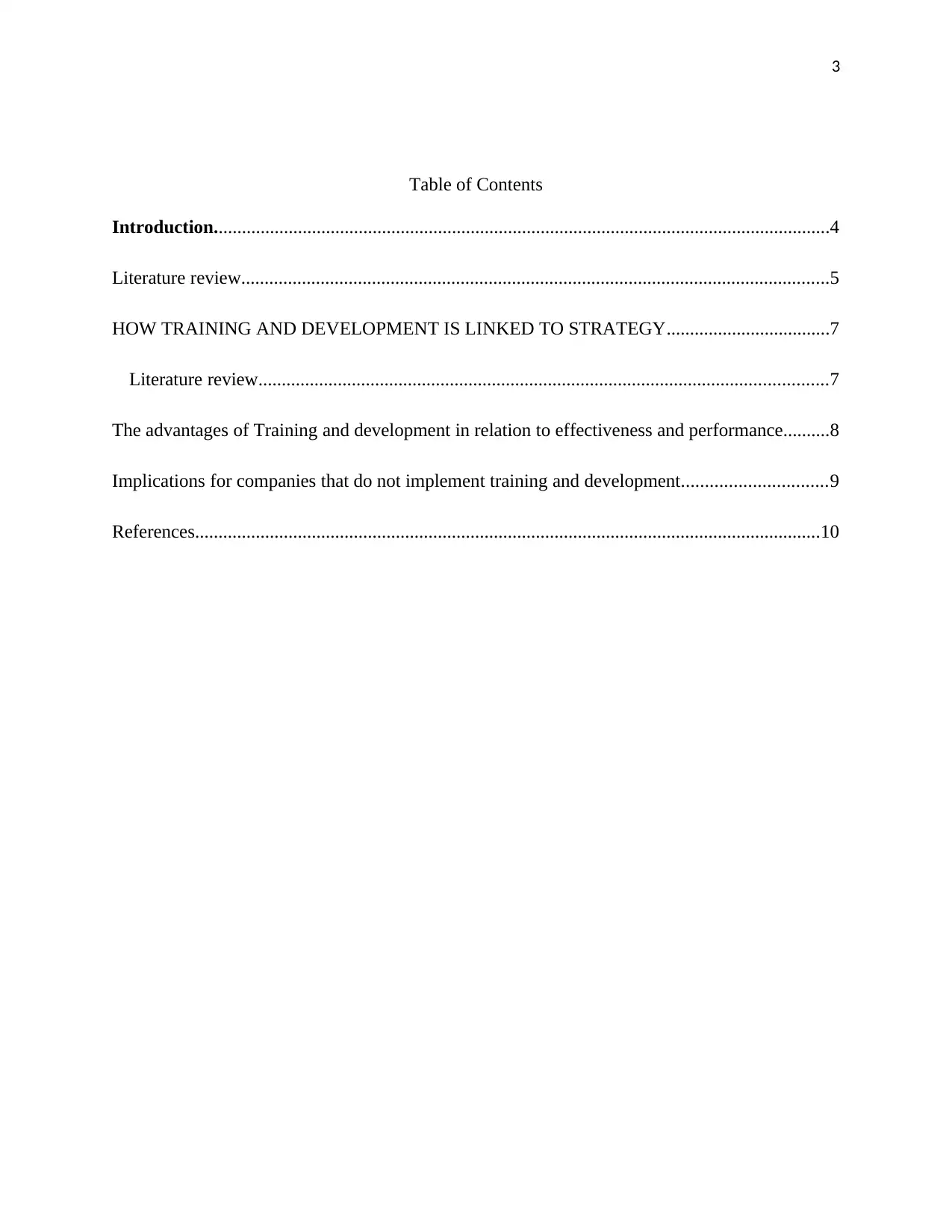
3
Table of Contents
Introduction....................................................................................................................................4
Literature review..............................................................................................................................5
HOW TRAINING AND DEVELOPMENT IS LINKED TO STRATEGY...................................7
Literature review..........................................................................................................................7
The advantages of Training and development in relation to effectiveness and performance..........8
Implications for companies that do not implement training and development...............................9
References......................................................................................................................................10
Table of Contents
Introduction....................................................................................................................................4
Literature review..............................................................................................................................5
HOW TRAINING AND DEVELOPMENT IS LINKED TO STRATEGY...................................7
Literature review..........................................................................................................................7
The advantages of Training and development in relation to effectiveness and performance..........8
Implications for companies that do not implement training and development...............................9
References......................................................................................................................................10
⊘ This is a preview!⊘
Do you want full access?
Subscribe today to unlock all pages.

Trusted by 1+ million students worldwide
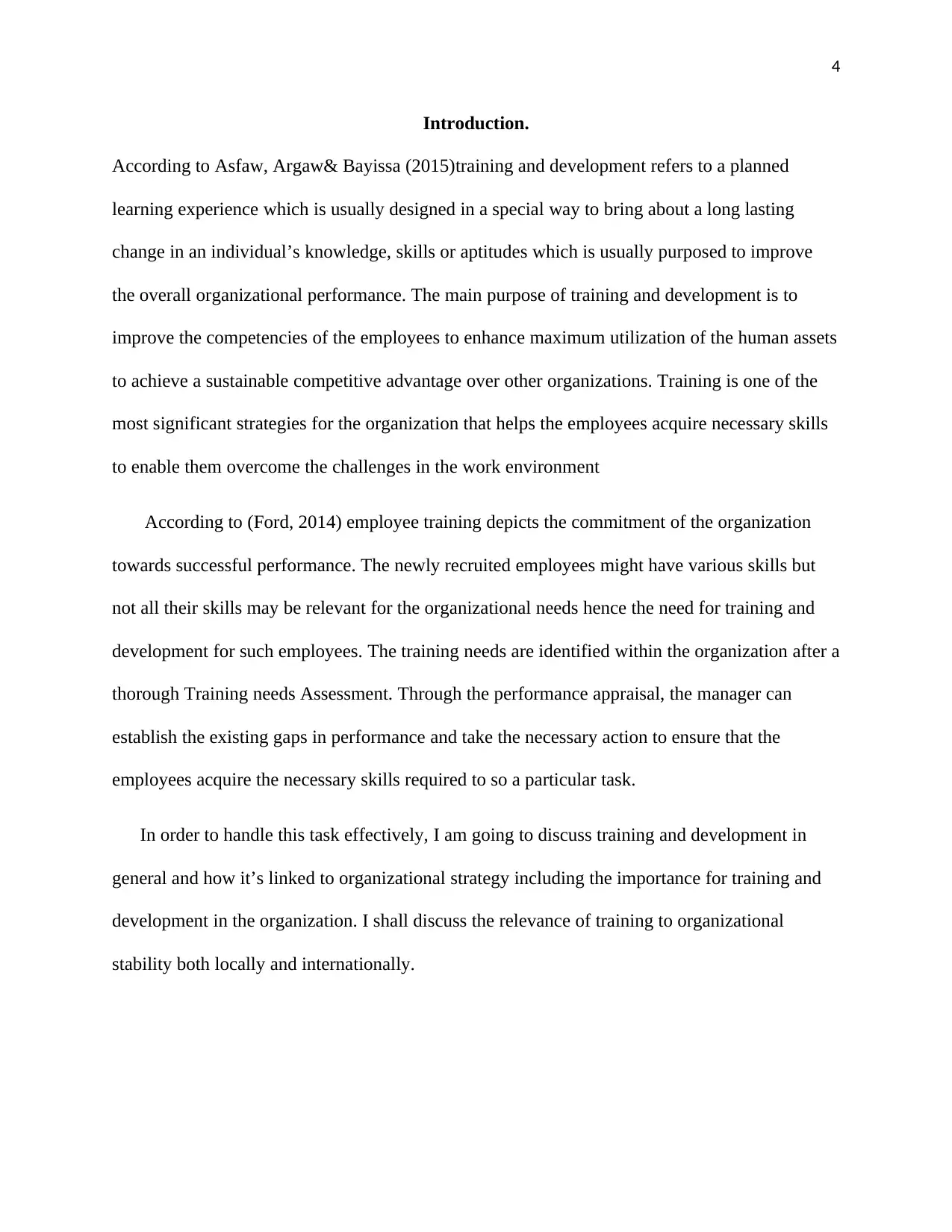
4
Introduction.
According to Asfaw, Argaw& Bayissa (2015)training and development refers to a planned
learning experience which is usually designed in a special way to bring about a long lasting
change in an individual’s knowledge, skills or aptitudes which is usually purposed to improve
the overall organizational performance. The main purpose of training and development is to
improve the competencies of the employees to enhance maximum utilization of the human assets
to achieve a sustainable competitive advantage over other organizations. Training is one of the
most significant strategies for the organization that helps the employees acquire necessary skills
to enable them overcome the challenges in the work environment
According to (Ford, 2014) employee training depicts the commitment of the organization
towards successful performance. The newly recruited employees might have various skills but
not all their skills may be relevant for the organizational needs hence the need for training and
development for such employees. The training needs are identified within the organization after a
thorough Training needs Assessment. Through the performance appraisal, the manager can
establish the existing gaps in performance and take the necessary action to ensure that the
employees acquire the necessary skills required to so a particular task.
In order to handle this task effectively, I am going to discuss training and development in
general and how it’s linked to organizational strategy including the importance for training and
development in the organization. I shall discuss the relevance of training to organizational
stability both locally and internationally.
Introduction.
According to Asfaw, Argaw& Bayissa (2015)training and development refers to a planned
learning experience which is usually designed in a special way to bring about a long lasting
change in an individual’s knowledge, skills or aptitudes which is usually purposed to improve
the overall organizational performance. The main purpose of training and development is to
improve the competencies of the employees to enhance maximum utilization of the human assets
to achieve a sustainable competitive advantage over other organizations. Training is one of the
most significant strategies for the organization that helps the employees acquire necessary skills
to enable them overcome the challenges in the work environment
According to (Ford, 2014) employee training depicts the commitment of the organization
towards successful performance. The newly recruited employees might have various skills but
not all their skills may be relevant for the organizational needs hence the need for training and
development for such employees. The training needs are identified within the organization after a
thorough Training needs Assessment. Through the performance appraisal, the manager can
establish the existing gaps in performance and take the necessary action to ensure that the
employees acquire the necessary skills required to so a particular task.
In order to handle this task effectively, I am going to discuss training and development in
general and how it’s linked to organizational strategy including the importance for training and
development in the organization. I shall discuss the relevance of training to organizational
stability both locally and internationally.
Paraphrase This Document
Need a fresh take? Get an instant paraphrase of this document with our AI Paraphraser

5
Literature review
According to Rodriguez & Walters (2017) training and development is very essential for the
success of any organization in terms of achievement of the stipulated goals and objectives.
Zahra, Iram & Naeem (2014) carried out several studies in the field of training and development
of employees at the work place and established that training and development: equips employees
with relevant skills to perform their specific tasks which enhances organizational success,
prepares employees for future senior roles in the organization, makes employees to be less prone
to redundancy due to changes in technology, consumer demands ,Increases organizational
productivity as skilled employees perform better hence increased output, improves the skills
possessed by the employees in the organization especially for the newly recruited employees,
enables the employees identify their career paths in life and work hard to eliminate the barriers to
their career prospective within the organization, improves the quality of working life for the
employees which enables them to have control over their future career, motivates the employees
since they feel valued by the organization, reduces the employees turnover rate due to a feeling
of job satisfaction.
Literature review
According to Rodriguez & Walters (2017) training and development is very essential for the
success of any organization in terms of achievement of the stipulated goals and objectives.
Zahra, Iram & Naeem (2014) carried out several studies in the field of training and development
of employees at the work place and established that training and development: equips employees
with relevant skills to perform their specific tasks which enhances organizational success,
prepares employees for future senior roles in the organization, makes employees to be less prone
to redundancy due to changes in technology, consumer demands ,Increases organizational
productivity as skilled employees perform better hence increased output, improves the skills
possessed by the employees in the organization especially for the newly recruited employees,
enables the employees identify their career paths in life and work hard to eliminate the barriers to
their career prospective within the organization, improves the quality of working life for the
employees which enables them to have control over their future career, motivates the employees
since they feel valued by the organization, reduces the employees turnover rate due to a feeling
of job satisfaction.
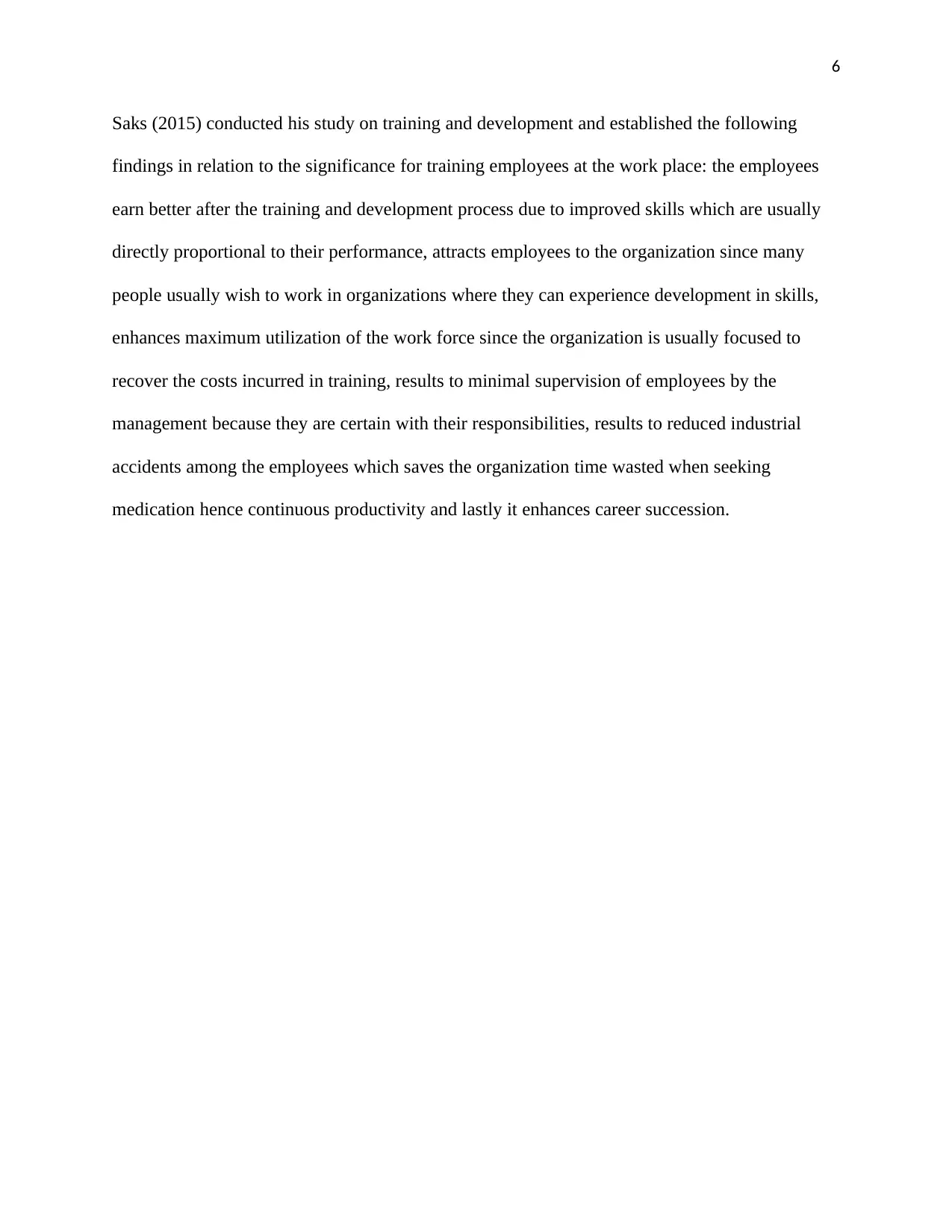
6
Saks (2015) conducted his study on training and development and established the following
findings in relation to the significance for training employees at the work place: the employees
earn better after the training and development process due to improved skills which are usually
directly proportional to their performance, attracts employees to the organization since many
people usually wish to work in organizations where they can experience development in skills,
enhances maximum utilization of the work force since the organization is usually focused to
recover the costs incurred in training, results to minimal supervision of employees by the
management because they are certain with their responsibilities, results to reduced industrial
accidents among the employees which saves the organization time wasted when seeking
medication hence continuous productivity and lastly it enhances career succession.
Saks (2015) conducted his study on training and development and established the following
findings in relation to the significance for training employees at the work place: the employees
earn better after the training and development process due to improved skills which are usually
directly proportional to their performance, attracts employees to the organization since many
people usually wish to work in organizations where they can experience development in skills,
enhances maximum utilization of the work force since the organization is usually focused to
recover the costs incurred in training, results to minimal supervision of employees by the
management because they are certain with their responsibilities, results to reduced industrial
accidents among the employees which saves the organization time wasted when seeking
medication hence continuous productivity and lastly it enhances career succession.
⊘ This is a preview!⊘
Do you want full access?
Subscribe today to unlock all pages.

Trusted by 1+ million students worldwide
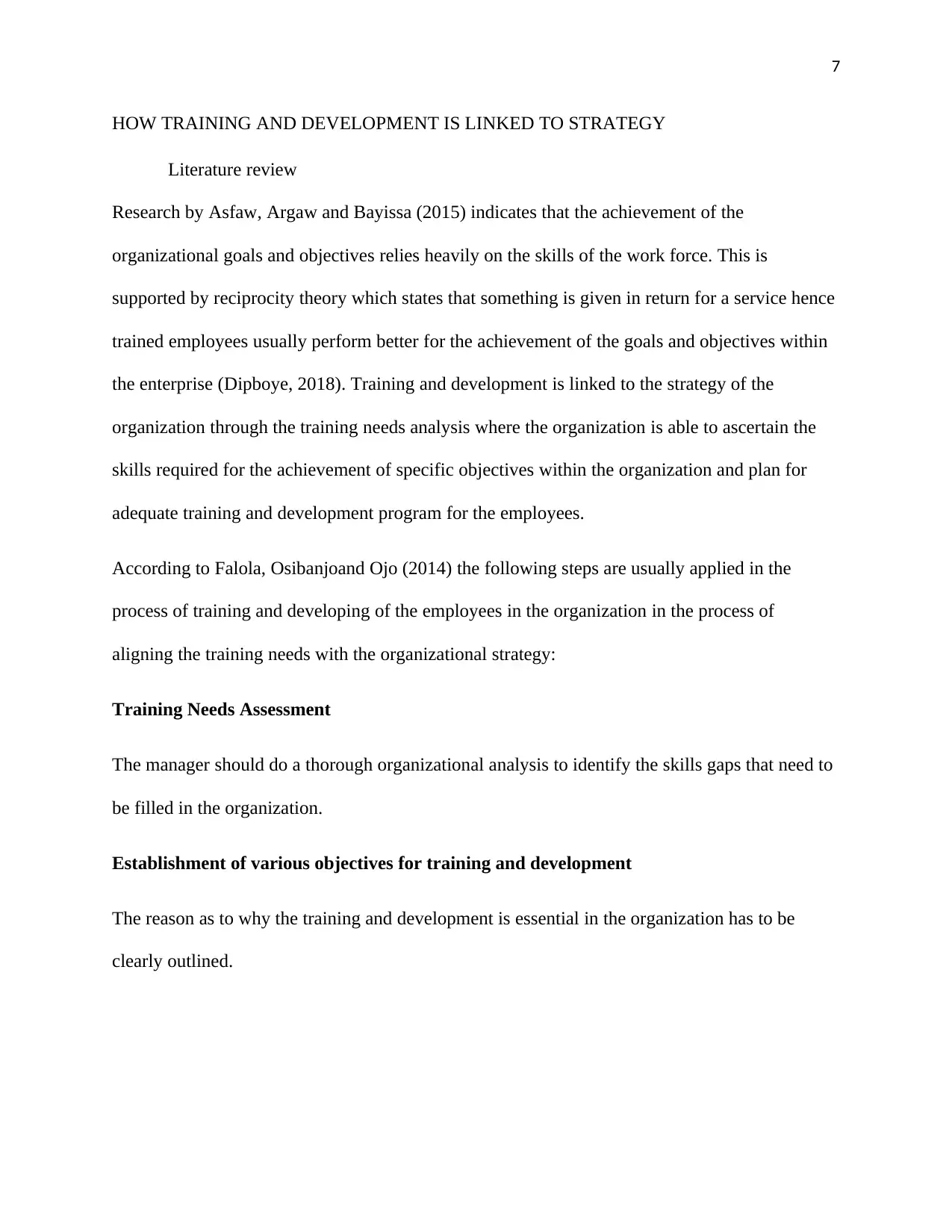
7
HOW TRAINING AND DEVELOPMENT IS LINKED TO STRATEGY
Literature review
Research by Asfaw, Argaw and Bayissa (2015) indicates that the achievement of the
organizational goals and objectives relies heavily on the skills of the work force. This is
supported by reciprocity theory which states that something is given in return for a service hence
trained employees usually perform better for the achievement of the goals and objectives within
the enterprise (Dipboye, 2018). Training and development is linked to the strategy of the
organization through the training needs analysis where the organization is able to ascertain the
skills required for the achievement of specific objectives within the organization and plan for
adequate training and development program for the employees.
According to Falola, Osibanjoand Ojo (2014) the following steps are usually applied in the
process of training and developing of the employees in the organization in the process of
aligning the training needs with the organizational strategy:
Training Needs Assessment
The manager should do a thorough organizational analysis to identify the skills gaps that need to
be filled in the organization.
Establishment of various objectives for training and development
The reason as to why the training and development is essential in the organization has to be
clearly outlined.
HOW TRAINING AND DEVELOPMENT IS LINKED TO STRATEGY
Literature review
Research by Asfaw, Argaw and Bayissa (2015) indicates that the achievement of the
organizational goals and objectives relies heavily on the skills of the work force. This is
supported by reciprocity theory which states that something is given in return for a service hence
trained employees usually perform better for the achievement of the goals and objectives within
the enterprise (Dipboye, 2018). Training and development is linked to the strategy of the
organization through the training needs analysis where the organization is able to ascertain the
skills required for the achievement of specific objectives within the organization and plan for
adequate training and development program for the employees.
According to Falola, Osibanjoand Ojo (2014) the following steps are usually applied in the
process of training and developing of the employees in the organization in the process of
aligning the training needs with the organizational strategy:
Training Needs Assessment
The manager should do a thorough organizational analysis to identify the skills gaps that need to
be filled in the organization.
Establishment of various objectives for training and development
The reason as to why the training and development is essential in the organization has to be
clearly outlined.
Paraphrase This Document
Need a fresh take? Get an instant paraphrase of this document with our AI Paraphraser
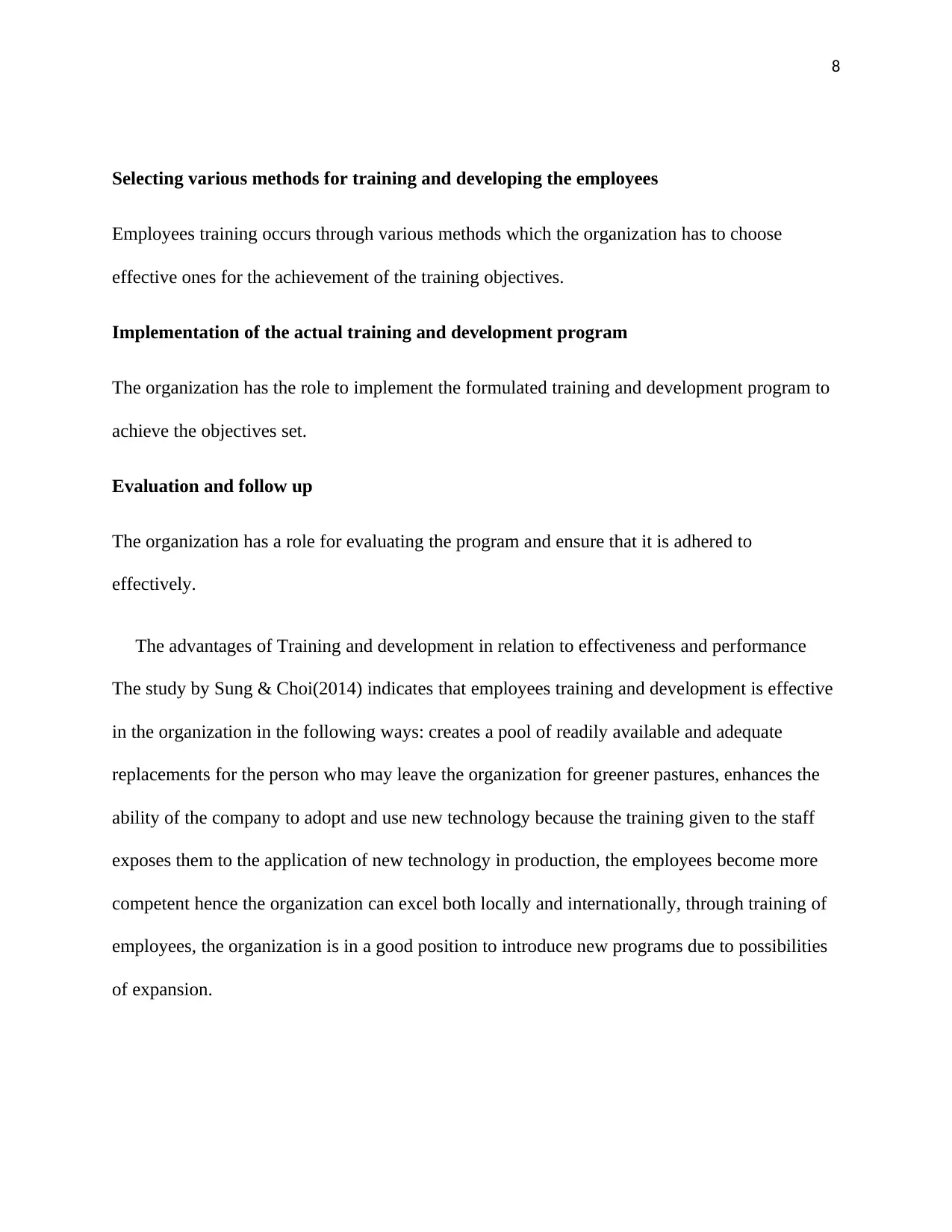
8
Selecting various methods for training and developing the employees
Employees training occurs through various methods which the organization has to choose
effective ones for the achievement of the training objectives.
Implementation of the actual training and development program
The organization has the role to implement the formulated training and development program to
achieve the objectives set.
Evaluation and follow up
The organization has a role for evaluating the program and ensure that it is adhered to
effectively.
The advantages of Training and development in relation to effectiveness and performance
The study by Sung & Choi(2014) indicates that employees training and development is effective
in the organization in the following ways: creates a pool of readily available and adequate
replacements for the person who may leave the organization for greener pastures, enhances the
ability of the company to adopt and use new technology because the training given to the staff
exposes them to the application of new technology in production, the employees become more
competent hence the organization can excel both locally and internationally, through training of
employees, the organization is in a good position to introduce new programs due to possibilities
of expansion.
Selecting various methods for training and developing the employees
Employees training occurs through various methods which the organization has to choose
effective ones for the achievement of the training objectives.
Implementation of the actual training and development program
The organization has the role to implement the formulated training and development program to
achieve the objectives set.
Evaluation and follow up
The organization has a role for evaluating the program and ensure that it is adhered to
effectively.
The advantages of Training and development in relation to effectiveness and performance
The study by Sung & Choi(2014) indicates that employees training and development is effective
in the organization in the following ways: creates a pool of readily available and adequate
replacements for the person who may leave the organization for greener pastures, enhances the
ability of the company to adopt and use new technology because the training given to the staff
exposes them to the application of new technology in production, the employees become more
competent hence the organization can excel both locally and internationally, through training of
employees, the organization is in a good position to introduce new programs due to possibilities
of expansion.

9
Implications for companies that do not implement training and development
Chao (2014) states that failure to conduct training and development in the organization results to:
a) Slow growth and development
An organization with employees who are not well trained hardly achieves its objectives
hence slow growth.
b) High turnover rate
Complexity of tasks result to turnover among the employees in the organization
c) In adequate staff
Does not attract many skilled employees.
Conclusion
Training and development is very vital for the success of the organization hence should
be given a first priority.
Implications for companies that do not implement training and development
Chao (2014) states that failure to conduct training and development in the organization results to:
a) Slow growth and development
An organization with employees who are not well trained hardly achieves its objectives
hence slow growth.
b) High turnover rate
Complexity of tasks result to turnover among the employees in the organization
c) In adequate staff
Does not attract many skilled employees.
Conclusion
Training and development is very vital for the success of the organization hence should
be given a first priority.
⊘ This is a preview!⊘
Do you want full access?
Subscribe today to unlock all pages.

Trusted by 1+ million students worldwide

10
References
Asfaw, A.M., Argaw, M.D. and Bayissa, L., 2015. The impact of training and development on
employee performance and effectiveness: A case study of District Five Administration
Office, Bole Sub-City, Addis Ababa, Ethiopia. Journal of Human Resource and
Sustainability Studies, 3(04), p.188.
Chao, G.T., 2014. Unstructured training and development: The role of organizational
socialization. In improving training effectiveness in work organizations (pp. 141-164).
Psychology Press.
Dipboye, R.L., 2018. Employee Training and Development. In The Emerald Review of
Industrial and Organizational Psychology (pp. 581-624). Emerald Publishing Limited.
Falola, H.O., Osibanjo, A.O. and Ojo, I.S., 2014. Effectiveness of training and development on
employees' performance and organization competitiveness in the Nigerian banking
industry. Bulletin of the Transilvania University of braşov, 7(1), p.161.
Ford, J. K. (Ed.). (2014). Improving training effectiveness in work organizations. Psychology
Press.
Rodriguez, J., & Walters, K. (2017). The importance of training and development in employee
performance and evaluation.
Saks, A. (2015). Managing Performance through Training & Development, (Canadian Ed.).
Nelson Education.
References
Asfaw, A.M., Argaw, M.D. and Bayissa, L., 2015. The impact of training and development on
employee performance and effectiveness: A case study of District Five Administration
Office, Bole Sub-City, Addis Ababa, Ethiopia. Journal of Human Resource and
Sustainability Studies, 3(04), p.188.
Chao, G.T., 2014. Unstructured training and development: The role of organizational
socialization. In improving training effectiveness in work organizations (pp. 141-164).
Psychology Press.
Dipboye, R.L., 2018. Employee Training and Development. In The Emerald Review of
Industrial and Organizational Psychology (pp. 581-624). Emerald Publishing Limited.
Falola, H.O., Osibanjo, A.O. and Ojo, I.S., 2014. Effectiveness of training and development on
employees' performance and organization competitiveness in the Nigerian banking
industry. Bulletin of the Transilvania University of braşov, 7(1), p.161.
Ford, J. K. (Ed.). (2014). Improving training effectiveness in work organizations. Psychology
Press.
Rodriguez, J., & Walters, K. (2017). The importance of training and development in employee
performance and evaluation.
Saks, A. (2015). Managing Performance through Training & Development, (Canadian Ed.).
Nelson Education.
Paraphrase This Document
Need a fresh take? Get an instant paraphrase of this document with our AI Paraphraser
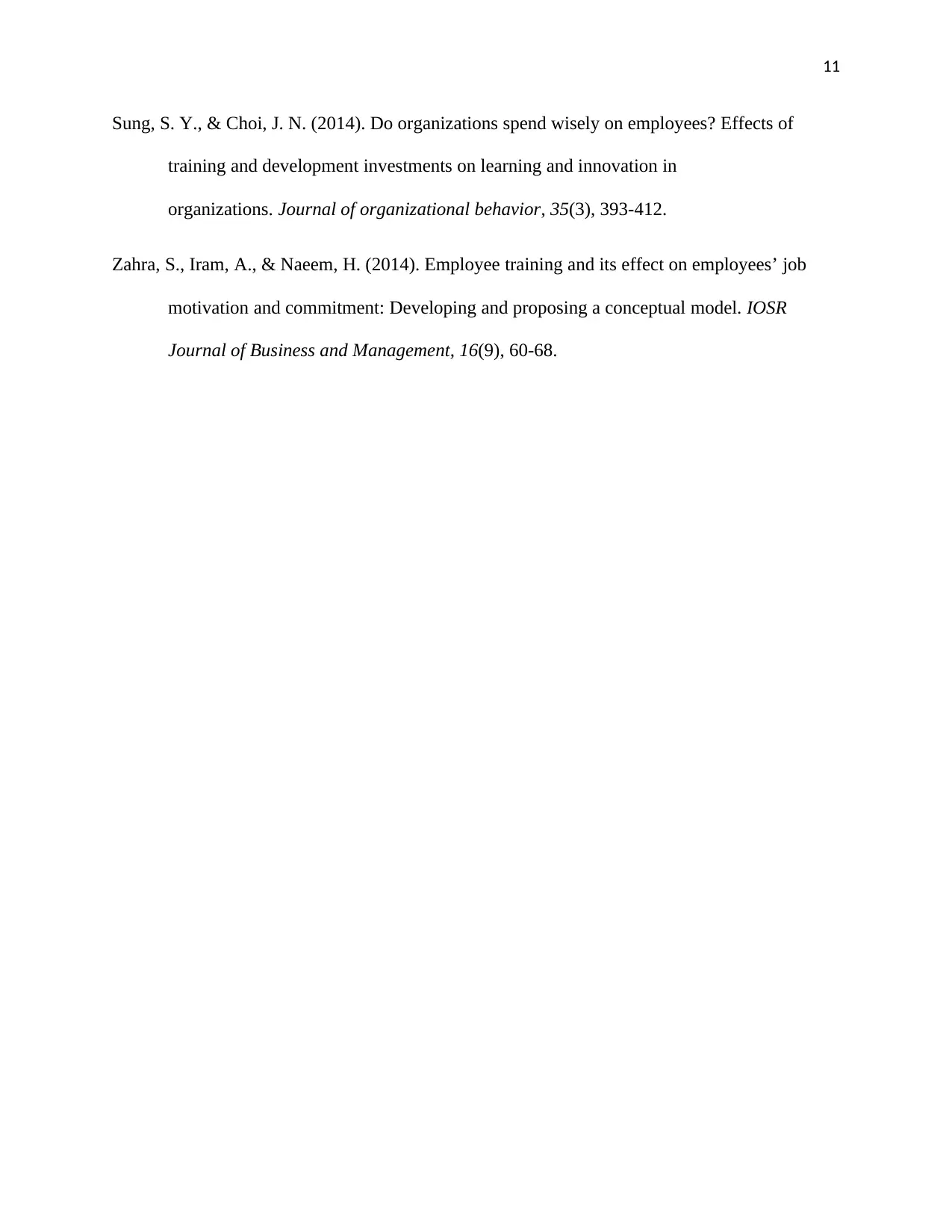
11
Sung, S. Y., & Choi, J. N. (2014). Do organizations spend wisely on employees? Effects of
training and development investments on learning and innovation in
organizations. Journal of organizational behavior, 35(3), 393-412.
Zahra, S., Iram, A., & Naeem, H. (2014). Employee training and its effect on employees’ job
motivation and commitment: Developing and proposing a conceptual model. IOSR
Journal of Business and Management, 16(9), 60-68.
Sung, S. Y., & Choi, J. N. (2014). Do organizations spend wisely on employees? Effects of
training and development investments on learning and innovation in
organizations. Journal of organizational behavior, 35(3), 393-412.
Zahra, S., Iram, A., & Naeem, H. (2014). Employee training and its effect on employees’ job
motivation and commitment: Developing and proposing a conceptual model. IOSR
Journal of Business and Management, 16(9), 60-68.
1 out of 11
Related Documents
Your All-in-One AI-Powered Toolkit for Academic Success.
+13062052269
info@desklib.com
Available 24*7 on WhatsApp / Email
![[object Object]](/_next/static/media/star-bottom.7253800d.svg)
Unlock your academic potential
Copyright © 2020–2025 A2Z Services. All Rights Reserved. Developed and managed by ZUCOL.




